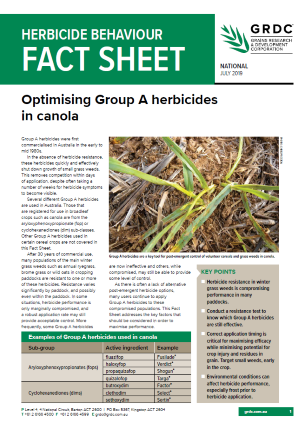Optimising Group A herbicides in canola
Optimising Group A herbicides in canola
Published: 01 Aug 2019
Group A herbicides control volunteer cereals and grass weeds in canola. They are most effective when there is no herbicide resistance. However, resistance in winter grass weeds is a problem.
About Group A herbicides
Group A herbicides were first sold in Australia in the early to mid-1980s.
They work fast and are very effective. This is especially so when there is no herbicide resistance. Group A herbicides shut down the growth of small grass weeds. They remove competition within days. However, it can take some time before herbicide symptoms are visible.
In Australia, farmers use various Group A herbicides. There are two sub-classes of herbicides registered for use in broadleaf crops. Farmers use them on crops such as canola. This includes the aryloxyphenoxypropionate (fop) or cyclohexanediones (dim) sub-classes. Other Group A herbicides used in certain cereal crops are not covered in this fact sheet.
Key points
- Group A herbicides work very well when there is no herbicide resistance.
- Herbicide resistance in winter grass weeds is a problem. Annual ryegrass, brome grass or wild oats are resistant to one or more of these herbicides.
- A resistance test will determine which Group A herbicides are still effective.
- Applying herbicides at the right time is important. It boosts effectiveness. It also reduces the risk of crop damage and grain residues. Target small weeds early in the crop.
- Environmental conditions can affect herbicide performance. This includes frost before application.
Useful Resources
Congreve, M. and Cameron, J. (2018). Understanding post-emergent herbicide weed control in Australian farming systems - a national reference manual for agronomic advisers. GRDC publication, Australia.
Grain Orana Alliance (2017). The impact of rate and timing of clethodim herbicide applications on canola performance (4 trial reports).
Saini, R., Boutsalis, P., Dolman, F., Gill, G., Preston, C. (2015). Maximise clethodim performance: impact of frost.
Saini, R., Malone, J., Preston, C., Gill, G. (2016). Frost reduces clethodim efficacy in clethodim-resistant rigid ryegrass (Lolium rigidum) populations. Weed Science 64(2):207-215
Zerner, M. and Wheeler, R. (2013). Clethodim tolerance in canola. SARDI trial report.
Want a printed copy?
Printed copies of some publications are available for growers, advisers and farming systems groups, for personal use and distribution at GRDC events.
Contact GroundCover Direct on 1800 11 00 44 or email ground-cover-direct@canprint.com.au to copies. Publications are free but postage and handling costs may apply.
Download PDF
Region: National

